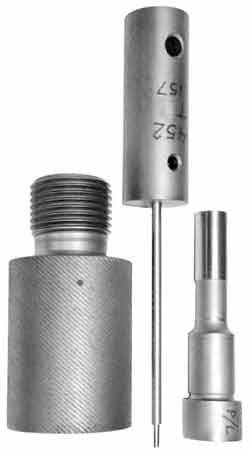|
|
|
Point Form Die w/bleed holes, -H type
|
| |

|
Quantity in Basket:
None
Catalog No.: PF-1-HB
Price: $670.00
Shipping Weight: 2.00 pounds
Sorry, we are no longer taking orders for the Point Form Die w/bleed holes, -H type on our legacy website. Please visit our new website at Corbins.com for all future orders. Any question/concerns you can reach us at sales@corbins.com Thank you
|
| |
PF-1-HB is a combined core swage, point form, and lead tip finishing die -- three operations in one stroke, for lead bullets with smooth ogive to shank transition. The benefit is both a cost savings over three separate dies, and a speed increase of 300%. This is truely a "One-And-Done" high speed swaging tool.
Please note:
You do not need to provide values for ALL of the options. If left blank, the most popular and useful value will be used. The options are offered in case you have a specific value in mind for your own reason. Feel comfortable in leaving blank any value about which you ae unsure or do not have a specific requirement.
The limitation of this die over separate operations is that it is only used for lead bullets, not jacketed. However, you can use gas checks or half jackets, or Base Guards, if they do not cover the bleed holes in the die.
Also, in some cases, you can create shapes and features with separate operations that are impossible to form in one stroke. For example, a pear-shaped hollow point cavity can be made by forming a HP in either the core seating operation (for jacketed or lead bullets), or with a hollow point punch in the core swage step. Then the cavity can be filled with lube, a polymer ball, or other material to keep it from collapsing when you push the bullet into the point forming die. The nose of the bullet rolls inward faster than the lower, larger portion of the ogive, and can encapsulate or close the cavity at the end, trapping the filler and leaving a pear-shaped cavity.
With a projecting tip on the end of the ejection punch, the PF-1-HB can make a hollow point cavity, but the cavity shape has to be tapered with a larger opening or straight. It cannot be larger inside than at the tip, since the cavity is formed by the shape of the tip itself, and the tip must be able to pull straight out again. No second operation is used to squeeze the open tip to a smaller diameter, sacrificing the added capability of the slower multi-step forming method.
Additionally, the hollow point can ONLY be the same size or smaller in diameter than the ejection punch. A large cavity can be made in a two or three step operation with a conical shaped HP seating punch, and then rolled around to any desired smaller size during point forming. But with the one-step PF-1-HB die, the hollow point is made by forming the end of the bullet around the projecting "probe" machined on the end of the ejection punch. It can only be as large as the ejector itself, and usually is stepped down to leave a clean flat end or meplat around the hollow point. Too thin an edge means a fragile, easily damaged point. So a typical punch might be 0.157 to 0.250 diameter (depending on the bullet caliber) with a HP probe of 0.080 to 0.150 diameter, leaving a margin around the hole that is at least .020-.025 inches wide.
You can specify a flat tip, a radius or semi-spitzer rounded tip, a sharp pointed tip, or a flat tip with a hollow point. If you select a HP style, you can also specify the length of the hollow point cavity and the diameter. Use the note to indicate a desired taper, if any. Otherwise we will use the minimum taper that provides easy release of the lead from the ejection punch. Be sure to do the math and make sure your hollow point dimensions are practical, and are physically possible. For example, the taper, diameter and length all have to work mathematically together -- you can't have a half inch long hollow point starting with a .2 inch opening and a 45 degree taper... try to draw it to scale. Also, if your ejection punch is .2 inch diameter and your bullet is a .224 caliber, you will have almost no nose left, just barely a radiused edge on the end of a cylinder. We'll notify you if we come across gross mathematical issues or if the bullet or punches would become too fragile with your specs.
Note that this die can make hollow base, hollow point handgun bullets, airgun pellets, or muzzle loader slugs in one stroke. It can open up a good market for custom bullets in these fields, if you wish.
|
|







































